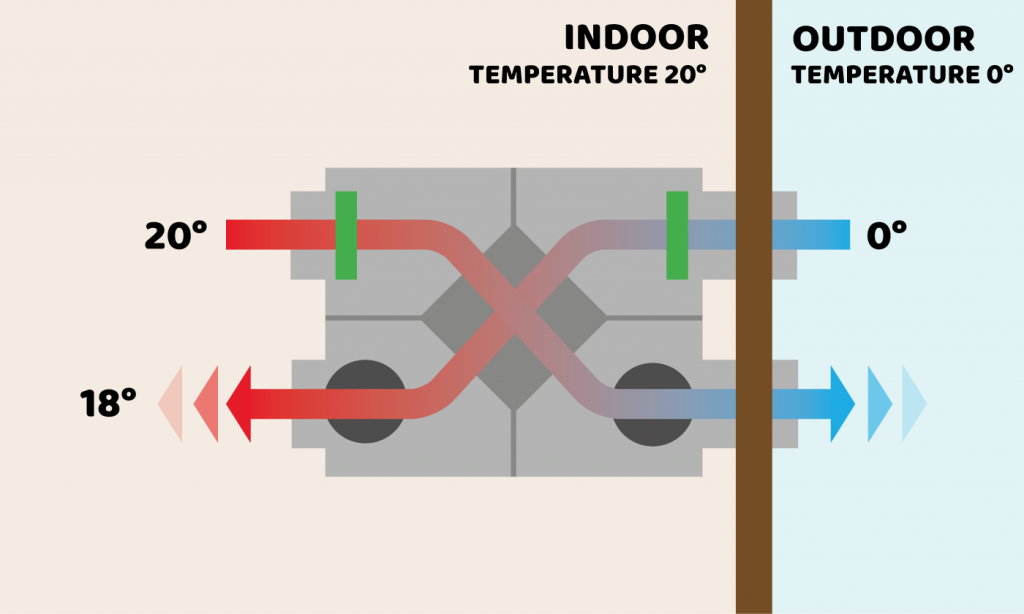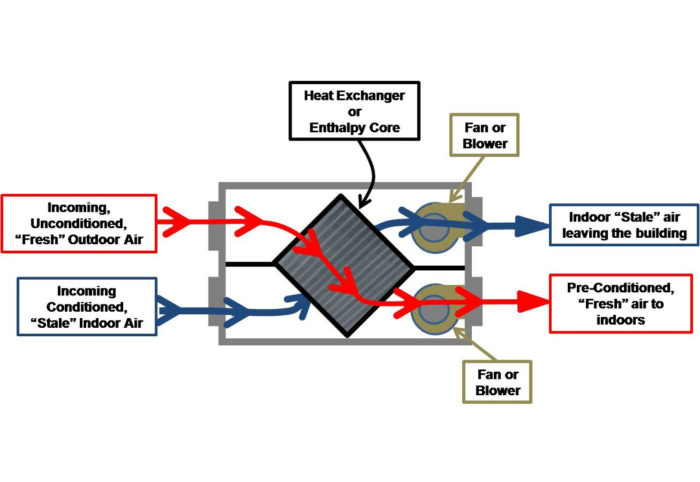The Importance of HRV in Green Homes
Wiki Article
Introducing the Secret Conveniences and Uses of Heat Recovery Ventilation in Sustainable Design
Heat Recovery Ventilation (HRV) systems play a crucial function in lasting style. They promote a continuous exchange of stale interior air with fresh exterior air, significantly improving indoor air top quality. HRVs add to power effectiveness by redeeming heat from worn down air, which can lower utility costs. Recognizing the multifaceted advantages and applications of HRVs reveals their significance in modern architecture. What other advantages do these systems provide in the pursuit of sustainability?Recognizing Heat Recovery Ventilation Solutions
Heat recovery ventilation (HRV) systems are designed to enhance indoor air high quality while minimizing power loss. These systems make use of a mechanical air flow method to exchange stagnant interior air with fresh outdoor air, making sure a constant supply of tidy air. By recording warm from the exhaust air, HRVs precondition incoming air, lowering the demand on home heating and cooling systems. This process not only enhances thermal comfort but also contributes to energy efficiency in household and commercial structures. In addition, HRV systems help manage moisture levels and decrease interior pollutants, promoting a healthier living environment. Their strategic execution is necessary for accomplishing sustainable design goals, as they offer an equilibrium between energy conservation and occupant wellness.Exactly How HRV Equipment Work
While many may recognize with air flow systems, recognizing just how warm recuperation air flow (HRV) systems run is crucial for valuing their benefits. HRV systems operate by exchanging stale indoor air with fresh outside air while moving heat in between the two streams. This process happens in a heat exchanger, where heat from the outgoing air heats the incoming air throughout cooler months, minimizing power loss. Conversely, in warmer months, the system can cool down incoming air making use of the cooler outbound air. HRVs are furnished with followers to facilitate air flow and filters to eliminate particulates, ensuring a constant, well balanced ventilation procedure. This innovative design not only boosts energy effectiveness however additionally adds to keeping a comfy indoor atmosphere.Enhancing Indoor Air Top Quality
Interior air top quality can significantly influence health and wellness and well-being, making effective ventilation important in modern homes. Heat Recovery Ventilation (HRV) systems play an essential function in maintaining indoor air quality by continually exchanging stale interior air with fresh outdoor air. This procedure not just minimizes air-borne pollutants but likewise lessens humidity degrees, which can cause mold development and breathing problems. HRV systems filter inbound air, removing irritants and particulates, thus offering a healthier living setting. In addition, these systems aid eliminate odors and volatile organic substances (VOCs) generally discovered in house products. By ensuring a constant flow of tidy air, HRV systems contribute to an overall enhanced interior environment, promoting convenience and health for occupants.Energy Performance and Expense Financial Savings
Energy efficiency attracts attention as a significant advantage of Heat Recovery Ventilation (HRV) systems. By catching and reusing the heat from tired indoor air, HRVs minimize the power required for home heating incoming fresh air, leading to minimized energy consumption. This effectiveness translates right into lower utility expenses, using substantial expense savings for house owners and services alike. Furthermore, HRV systems commonly get power performance motivations and rebates, better improving their financial appeal. In time, the initial investment in HRV modern technology can lead to a positive return on financial investment with decreased energy expenditures. Subsequently, the integration of HRV systems not just advertises sustainable design yet additionally gives a useful service for achieving lasting power savings and financial benefits.Ecological Advantages of HRV

A plethora of environmental advantages occurs from the implementation of Heat Recovery Ventilation (HRV) systems. By successfully transferring warm from exhaust air to inbound fresh air, HRVs considerably minimize the power required for heating and cooling down spaces. This power efficiency translates to decrease greenhouse gas exhausts, contributing to a decrease in the total carbon impact of buildings. Additionally, HRV systems improve indoor air quality by continually distributing fresh air, thus minimizing the concentration of indoor toxins and allergens. The decrease in power consumption help in saving natural resources, making HRVs an essential element of sustainable design. On the whole, the environmental advantages view website of HRVs play a vital function in advertising a much healthier planet and cultivating environmentally friendly building techniques.
Versatile Applications in Modern Design
Heat recovery ventilation (HRV) systems are significantly being integrated into both household and industrial architectural tasks. In property settings, HRVs improve indoor air top quality while making the most of energy effectiveness. On the other hand, in business areas, these systems enhance air flow techniques, showing their convenience in contemporary building applications.Residential Projects Assimilation
While modern-day style significantly highlights sustainability, the assimilation of heat recovery air flow systems in domestic tasks has arised as a useful remedy for improving interior air top quality and energy performance. These systems efficiently move warm from exhaust air to incoming fresh air, minimizing power loss and minimizing home heating or cooling down demands. In new builds and retrofits alike, warmth healing air flow can be effortlessly integrated, supplying house owners with a healthier living atmosphere while reducing energy costs. Furthermore, with boosting recognition of ecological impacts, more designers and home builders are acknowledging the long-term benefits of these systems. Because of this, warm healing air flow has actually come to be an important element of sustainable household style, showcasing versatility and dedication to environment-friendly methods.Commercial Rooms Optimization
As modern business spaces evolve to satisfy the demands of sustainability and performance, the execution of warm healing ventilation systems emerges as an essential strategy for maximizing indoor settings. These systems promote the exchange of stale indoor air with fresh outside air while reclaiming warmth power, substantially minimizing power usage. This not just improves comfort for passengers however additionally aids in decreasing functional expenses. Functional applications can be observed in workplaces, retail spaces, and schools, where air quality and temperature level control are critical. In addition, integrating heat recovery air flow aligns with green building accreditations, better promoting ecological responsibility. Eventually, taking on such systems in business design not only adds to sustainability goals yet likewise cultivates much healthier, more effective areas for customers.
Integrating HRV Into Sustainable Design Practices
Integrating heat healing ventilation (HRV) systems into sustainable style techniques provides substantial benefits in energy performance and interior air quality. By utilizing HRV, designers can develop affordable options that not just lower energy intake however likewise enhance the overall comfort of view interior settings. This placement with sustainability objectives placements HRV as a vital element in contemporary architectural methods.
Energy Performance Improvement
By integrating warmth healing air flow (HRV) systems right into lasting layout practices, engineers and builders can considerably improve power effectiveness in modern buildings. HRV systems work by catching heat from outbound stagnant air and moving it to incoming fresh air, reducing the energy needed for heating or cooling down interior rooms. This process not just decreases dependence on conventional a/c systems yet likewise reduces general energy intake. Additionally, HRV systems can help maintain a regular indoor temperature, reducing peak power demands. By incorporating these systems, structures can achieve considerable reductions in utility costs and carbon footprints, lining up with sustainability objectives. Eventually, HRV innovation represents a functional remedy for enhancing energy effectiveness in the built atmosphere, advertising more responsible source usage.Indoor Air High Quality Improvement
Just how can warmth recuperation air flow (HRV) systems contribute to exceptional interior air quality in contemporary structures? HRV systems efficiently exchange stagnant interior air with fresh outside air while recovering heat energy, minimizing temperature level changes. This process decreases the focus of indoor pollutants, such as volatile natural substances (VOCs), allergens, and moisture, which can wear away air quality and effect owner health. By preserving ideal humidity degrees and making certain a constant supply of tidy air, HRVs aid create a healthier indoor setting. Additionally, these systems can be incorporated into lasting style techniques, advertising power efficiency alongside enhanced air quality. HRV Heat Recovery Ventilation. HRV innovation plays a vital role in progressing total passenger comfort and wellness in contemporary architectural layouts.Economical Layout Solutions

Regularly Asked Questions
What Upkeep Is Required for Heat Recovery Ventilation Equipments?

Maintenance for warmth healing air flow systems generally involves routine filter substitutes, cleaning of warmth exchangers, evaluation of followers and ducts, and making certain appropriate drain. These tasks assist preserve performance and lengthen the system's lifespan in time.
Can HRV Systems Be Set Up in Existing Structures?
Heat recovery ventilation systems can certainly be set up in existing buildings. HRV Heat Recovery Ventilation. Retrofitting needs mindful preparation and analysis of the building's layout, making certain compatibility with current systems while taking full advantage of energy performance and indoor air high qualityJust How Do HRV Equipment Impact Noise Degrees Inside?
HRV systems can influence indoor noise degrees by presenting audio from external sources with ventilation. Nonetheless, top quality installations usually integrate sound-dampening features, reducing noise effect while offering reliable air exchange and preserving comfort inside your home.Are There Any Type Of Drawbacks to Using HRV Systems?
The downsides of using HRV systems consist of potential high first expenses, maintenance obstacles, and the possibility of decreased interior air high quality if filters are sporadically changed, which could bring about concerns with humidity levels.How Do I Choose the Right HRV System for My Needs?
Picking the ideal warm recovery air flow system includes assessing specific requirements, such as developing size, environment, and power effectiveness goals. In addition, evaluating system features, installment demands, and maintenance factors to consider is crucial for peak efficiency and fulfillment.Report this wiki page